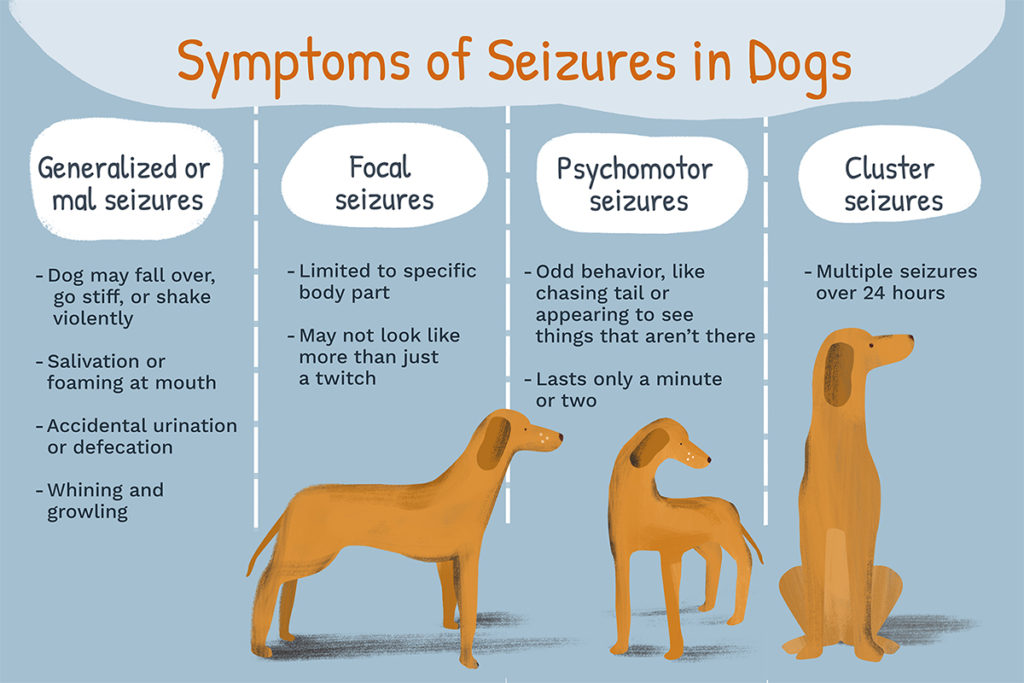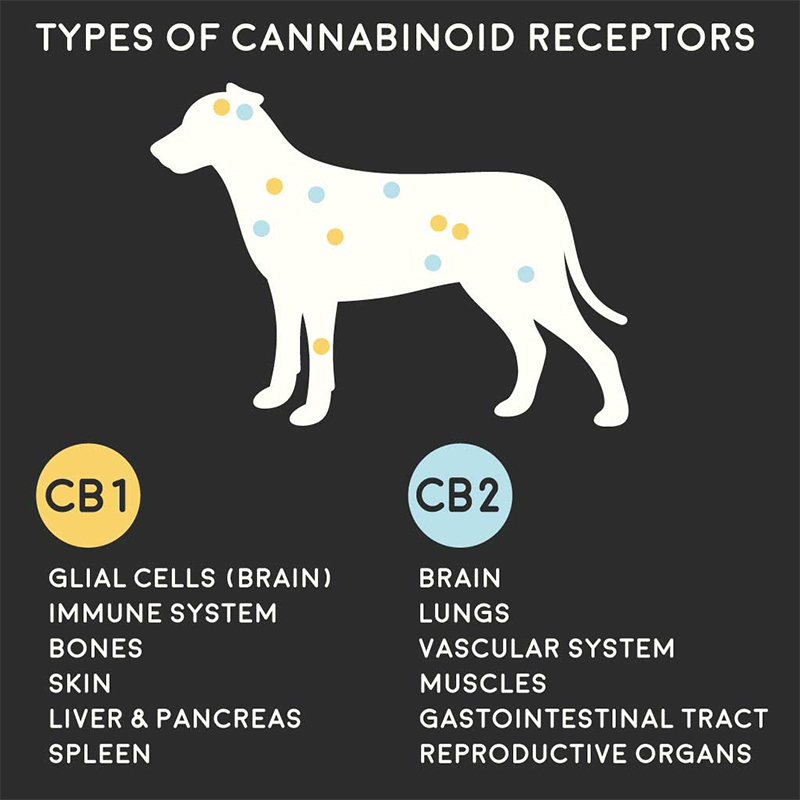
Seeing your dog have a seizure can be frightening to say the least. Seizures can be subtle, indicated by staring, a dazed appearance, whining, twitching, jerkiness, heavy breathing or unusually rapid eye movements. They can also be more severe, resulting in uncontrollable fits, tremors, and possibly loss of consciousness.
Seizures are basically caused by the abnormal firing of neurons in the brain. If your dog has seizures, no matter how mild or severe, you should consult your veterinarian to determine the cause.
That said, if you want to supplement your dog’s treatment with a natural, organic remedy then CBD oil should be your first choice. Cannabidiol (CBD) is a non-psychoactive compound found in the cannabis plant which has been shown to have anticonvulsant properties. Extracted from hemp (not marijuana) and legal in all states, CBD won’t make animals “high”, there are no known side effects and it’s impossible to overdose.

What Types of Seizures Can Dogs Have?
There are quite a few types of dog seizures that could affect your pet, including generalized or grand mal seizures, focal seizures, psychomotor seizures, and idiopathic seizures.
Idiopathic Seizures
Idiopathic epilepsy is a kind of seizure that stems from unknown causes. It’s most common in dogs that are older than 6 months but younger than 6 years. While idiopathic epilepsy is more common in Australian shepherds, German shepherds, beagles, border collies, Labrador retrievers, and Belgian Tervurens, any dog breed can experience it.
Psychomotor Seizures
Psychomotor seizures, for their part, last a few minutes and involve strange behavior. A dog experiencing this seizure might attack an invisible object or chase its tail. It can be tricky to identify psychomotor seizures since it isn’t always easy to differentiate normal, odd behavior from seizure-influenced behavior in dogs with epilepsy. A tell-tale sign, however, is that your dog will always perform the same odd act during every episode.
Focal Seizures
When there’s some abnormal electrical activity in only one section of your dog’s brain, your pet may experience what’s known as a focal seizure. This type of seizure might only last a few seconds. Nonetheless, you can tell when your dog is experiencing a focal seizure if you notice that he’s making some unusual movements on one side of his body or in one limb. Focal seizures sometimes transform into generalized seizures.
Generalized or Grand Mal Seizures
The most common kind of seizure in dogs is the generalized or grand mal seizure. These seizures are triggered by abnormal electrical activity taking place throughout the brain. During a grand mal seizure, which can last anywhere from a few seconds to even a few minutes, your dog might convulse and lose consciousness.
Traditional Treatments for Seizures – Prescription Drugs
For most veterinarians, the go-to treatment for seizures in dogs is some combination of anticonvulsant drugs, among them phenobarbital, potassium bromide, and diazepam. Dogs can be prescribed a mixture of these medications for the rest of their lives. For some dogs it’s enough to slow down the seizures, but it rarely stops them for good.
Unfortunately, those dogs are the lucky ones. Research shows that 30 percent of dogs with epilepsy continue to experience frequent seizures no matter how many different combinations of traditional drugs they try. They take medications every day, their humans spend a lot of money on those medications, and yet the dogs still suffer from seizures.
Even worse, many dogs on conventional anticonvulsant drugs experience terrible side effects. These side effects aren’t related to seizures but rather consequences of taking said drugs. Loss of coordination, weight gain, increased urination, lethargy, restlessness, and liver damage are all common side effects. Long-term use can make the side effects worse, and it can eventually get to the point where the medication is worse for the dog than the seizures themselves. It’s a problem facing countless dog owners. They have to decide which option is best for their dogs and there isn’t always a clear answer which makes them feel helpless and heartbroken.
CBD as a Solution – How Does It Work?
For generations, veterinarians have been prescribing the same anticonvulsant drugs to treat canine seizures. The specific formulas have changed and science has seen some advancements, but we’re still not at a point where seizures in dogs are easily manageable. We may never make it to that point, but the recent emergence of CBD oil is giving dog owners hope. As of yet there are no wide-spread studies of the effects of CBD oil on seizures in dogs, but anecdotal evidence and a few scientific studies show that CBD can be an extremely effective treatment for dogs suffering from frequent seizures, either alone or in combination with more traditional medications.

All mammals have an endocannabinoid system (ECS) which is a network of receptors that regulate body functions. Endocannabinoids are synthesized on demand by the body to maintain homeostasis – a stable internal environment. When a condition such as epilepsy interferes with this internal balance these internal mechanisms lag behind the body’s needs and not enough cannabinoids are available to return things to normalcy. Supplementing with CBD can help restore this balance.
Two types of endocannabinoid receptors have been identified: CB1 receptors are found primarily in the brain, nervous system, glands and organs while CB2 receptors are more prominent in the regulatory cells of the immune system. While CBD supplements benefit both types, their ability to calm overactive neurons and control seizures comes from the interactions with CB1 receptors. When the nervous system has been impacted by an illness or injury, supplementing with additional CBD can help restore homeostasis.
How Effective is CBD in Treating Canine Seizures?
While we won’t know exactly how CBD oil fights seizures in dogs until there’s more research, anecdotal feedback is highly encouraging. There are countless testimonials and endorsements from pet parents sharing how CBD has helped their furry friends overcome seizures, including cases where conventional medications haven’t helped. Regular use has shown to decrease both the frequency and severity of these seizures. In addition, preliminary research is so promising that the American Kennel Club Canine Health Foundation in cooperation with Colorado State University’s Veterinary Teaching Hospital conducted a study on CBD’s effectiveness in treating seizures in dogs.
The study looked at the short-term effects of CBD on the frequency of seizures in dogs with epilepsy. Twenty-six dogs with idiopathic epilepsy participated in the blind study and were randomly given either a placebo or CBD oil. Before the study, the dogs’ owners recorded how many seizures their dogs had within a certain amount of time, and they did the same thing during the 12-week study. At the end of the study, results showed that 89% of the dogs given CBD oil experienced a reduction in the number of seizures.
A larger study at CSU was just recently completed and while the results have not yet been analyzed they hope to have some preliminary results to share this year (2021) and a publication out by next year (2022). We will update this article to include that study as well once it has been released.
How Do I Treat My Dog’s Seizures with CBD Oil?
To reduce the severity and frequency of seizures (as well as the pain that results from the intense cramping of muscles during a seizure episode) you’ll want to give CBD to your pup regularly. While seizure reduction can typically be achieved by dosing your pet twice a day, dosage amounts can vary quite a bit from one situation to the next so it may be necessary to experiment to find the right amount and how often to give. Some dogs with epilepsy might require two to three doses every day if they have a higher frequency of seizures, whereas others with less severe seizures might only need a single dose per day.
Determining a proper starting dosage is based primarily on your dog’s weight or size. Smaller dogs will usually require a smaller dose than larger dogs, but a little experimentation may be needed to find the right balance. This dosage guide will help you get started. Keep in mind that you cannot overdose and there is no toxicity associated with CBD, so the general rule is to start out with a more conservative dosage and then increase as needed.

You’ll often find CBD for pets available as either an oil or as treats, but far and away the best option for your dog is going to be the oil. Oils have better bioavailability so your pups will be getting the full benefit of the CBD you’re paying for, it’s absorbed faster and more efficiently and will almost always be cheaper in the long run per mg of CBD. You’ll also want to be sure to purchase an oil that is THC-free. Our pets do not metabolize THC the same way humans do and it can be very harmful to them even in small doses.
NOTE: Many products touted (and even labeled) as CBD are in fact made exclusively with hemp seed oil which is from an entirely different part of the cannabis plant and contains none of the benefits of CBD. Whether you choose CBD oil or treats, be sure that you can view the company’s lab reports (Certificates of Analysis) prior to your purchase. These are reports generated by third-party independent labs that test each batch of CBD product to ensure that the amount of CBD in the product matches what is advertised. Quality, trusted CBD brands will have these reports readily and easily available on their websites. One additional note…Amazon DOES NOT allow the sale of CBD products in the US, so if you see a product for sale on Amazon claiming to be CBD you can be assured that it is not.
Final Thoughts
It’s hard to tell right off the bat if CBD oil is the right treatment solution for your four-legged friend’s seizure. The best way to find out is to start with a low dose and monitor the seizure activity. If your dog is showing improvement…great! Keep doing what you’re doing. If however you’re not seeing signs of improvement after a week or two feel free to gradually increase their dosage over a few days until you find that sweet spot. It takes a lot of research and experimentation to find the perfect dose, but once you have a reliable brand and the proper amount for your dog, your four-legged friend will experience a seizure-free life, and will definitely thank you for it.
If you would like to learn more about the additional benefits of regular CBD use for your pets please check out our blog article CBD Oil for Dogs | What You Need to Know.
Should you have any questions not addressed above or would like help determining the proper starting CBD dosage for your specific pet please feel free to reach out…we’re always happy to help! Feel free to contact us here, or reach out on Facebook, Instagram or Twitter.



